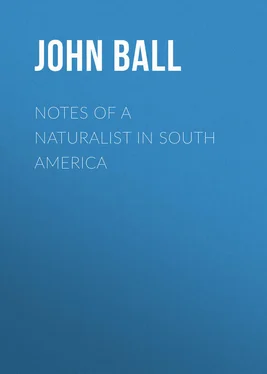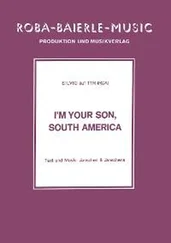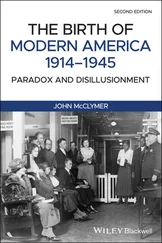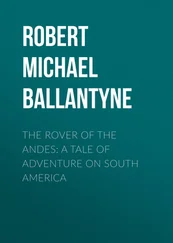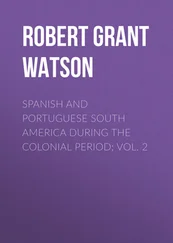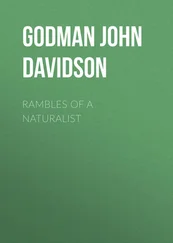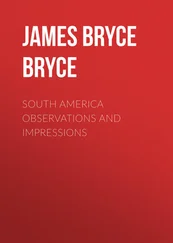John Ball - Notes of a naturalist in South America
Здесь есть возможность читать онлайн «John Ball - Notes of a naturalist in South America» — ознакомительный отрывок электронной книги совершенно бесплатно, а после прочтения отрывка купить полную версию. В некоторых случаях можно слушать аудио, скачать через торрент в формате fb2 и присутствует краткое содержание. Жанр: foreign_antique, foreign_prose, на английском языке. Описание произведения, (предисловие) а так же отзывы посетителей доступны на портале библиотеки ЛибКат.
- Название:Notes of a naturalist in South America
- Автор:
- Жанр:
- Год:неизвестен
- ISBN:нет данных
- Рейтинг книги:4 / 5. Голосов: 1
-
Избранное:Добавить в избранное
- Отзывы:
-
Ваша оценка:
- 80
- 1
- 2
- 3
- 4
- 5
Notes of a naturalist in South America: краткое содержание, описание и аннотация
Предлагаем к чтению аннотацию, описание, краткое содержание или предисловие (зависит от того, что написал сам автор книги «Notes of a naturalist in South America»). Если вы не нашли необходимую информацию о книге — напишите в комментариях, мы постараемся отыскать её.
Notes of a naturalist in South America — читать онлайн ознакомительный отрывок
Ниже представлен текст книги, разбитый по страницам. Система сохранения места последней прочитанной страницы, позволяет с удобством читать онлайн бесплатно книгу «Notes of a naturalist in South America», без необходимости каждый раз заново искать на чём Вы остановились. Поставьте закладку, и сможете в любой момент перейти на страницу, на которой закончили чтение.
Интервал:
Закладка:
Our course on April 14 lay rather far from land. It was known that yellow fever had broken out at Truxillo, and it was decided that we should run direct to Callao, without touching at that or any of the smaller places on the coast sometimes visited by the steamers. Although the air appeared to be somewhat hazy, the range of the Cordillera, more than a hundred miles distant, was distinctly seen in the afternoon. Very soon after we ran into a dense bank of fog, in which we were immersed for several hours, our cautious captain remaining meanwhile on the bridge, and the frequent cry of the steam-whistle ceased only when we steamed out of the fog into a brilliant star-lit night.
LOW TEMPERATURE OF THE COAST.
These fogs, which are frequent along the Peruvian coast, are the chief, if not the only, difficulty with which the navigator has to contend. When they rest over the land it becomes extremely difficult to make the ports, and at sea they involve the possible risk of collision. If this risk is at present but slight, it must become more serious when intercourse increases, as it must inevitably do if the Ship Canal should ever be completed; and for the general safety it may be expedient to prescribe special rules as to the course to be taken by vessels proceeding north or south along the coast. The origin of the fogs must be obvious to any one who considers the physical conditions of this region, to which I have already referred. The air must be very frequently near the point of saturation, and a slight fall of temperature, or the local intermixture of a body of moister air, must suffice to produce fog. The remarkable thing is that this should so very rarely undergo the further change requisite to cause rain. To some young Englishmen on board, the remarkable coolness of the air along this coast was a continual subject of jesting comment; and on more than one occasion the “Tropics” were emphatically declared to be “humbugs.” It is certain that for thirty-six hours before reaching Callao the shaded thermometer never reached 70°, and stood at noon, with a clear sky and a brisk southerly breeze, no higher than 68°.
CHAPTER II
Arrival at Callao – Quarantine – The war between Chili and Peru – Aspect of Lima – General Lynch – Andean railway to Chicla – Valley of the Rimac – Puente Infernillo – Chicla – Mountain-sickness – Flora of the Temperate zone of the Andes – Excursion to the higher region – Climate of the Cordillera – Remarks on the Andean flora – Return to Lima – Visit to a sugar-plantation – Condition of Peru – Prospect of anarchy.
The steam-whistle, sounding about daybreak on April 15, announced that we were again wrapped in fog. As the Islay advanced at half speed the fog lightened without clearing, until about nine a.m. we made the island of San Lorenzo, and, as the haze finally melted away into bright sunshine, found ourselves half an hour later in the harbour of Callao. The moment was exciting for those who, like myself, approached as strangers the shore which had in our childhood seemed so strange, so adventure-fraught, so distant. Already some one had pointed out the towers of the Cathedral of Lima, with the Cordillera apparently so near that the mountains must begin outside the gates. All stood on deck prepared to land – some already looking forward to luncheon in the city of Pizarro – and waiting only for the usual formalities of the visit of the sanidad . At length the officials came, and, after the usual parley over the ship’s side, it became apparent that the visit was no mere formality. At last the ominous word quarantine was heard, received at first with mere incredulity, as something too absurd, but at last taking the consistence of a stern fact. Since the outbreak of yellow fever among the troops at Truxillo, the Chilian authorities have naturally become nervously anxious to protect the occupying army from this danger, and every precaution is put in force. Under these circumstances, a ship coming from Guayaquil was naturally an object of suspicion. There certainly was not at the time any epidemic fever at that place; but, if reports be true, sporadic cases are not unfrequent, and that city is rarely, if ever, quite free from malignant zymotic disease. At last the discussion was closed, by a definite order that we should repair to the quarantine ground under the lee of the island of San Lorenzo.
IN QUARANTINE AT CALLAO.
Up to this time we had scarcely given attention to the scene immediately surrounding us; yet the harbour of Callao is at any time an interesting sight, and at this moment its aspect was peculiarly expressive. Although the Chilian forces had before this time become absolute masters of the entire seaboard of Peru, and there was no reason to apprehend any renewal of the struggle by sea, the memorials of the desperate encounters which marked the earlier phase of the war were here still fresh. Near the shore in several different directions were the wrecks of ships which had sunk while the captors were endeavouring to bring them into harbour, the masts sticking up idly above water and doing the duty of buoys. Still afloat, though looking terribly battered and scarcely seaworthy, was that remarkable little ship, the Huascar , looking a mere pigmy beside the warships in the harbour from which the Chilian, American, French, and Italian flags were flying, England being for the moment unrepresented.
The naval war between Chili and Peru was conducted at such a distance from Europe, and its causes were so little understood, that it excited but feeble interest. Even the circumstance that, in an encounter brought about by the incompetence and rashness of a British commander, the pigmy Peruvian force was able with impunity to inflict an affront on the national flag, scarcely excited in England more than momentary surprise. Nevertheless the story of the war, which yet awaits an impartial chronicler, 5 5 The only detailed account of the operations that I have seen is in a work entitled, “Histoire de la Guerre du Pacifique,” by Don Diego Barros Arana. Paris: 1881. It appears to be fairly accurate as to facts, but coloured by very decided Chilian sympathies.
abounds with dramatic incident. The record is ennobled by acts of heroic bravery on both sides, while at the same time it suggests matter for serious consideration to the professional seaman. The important part which small fast ships, carrying one or two heavy guns only, may play in the altered conditions of naval warfare has been often pointed out, but has been practically illustrated only in the war between Chili and Peru. It does not seem as if the importance of the lesson had been yet fully appreciated by those responsible for the naval administration of the great European powers.
For the remainder of the day, and during the whole of the 16th, we lay at anchor about half a mile from the shore of the island of San Lorenzo, a bare rough hill, mainly formed, it would seem, of volcanic rock overlaid in places by beds of very modern formation. All naturalists are familiar with the evidence adduced by Darwin, proving the considerable elevation of the island and the adjacent mainland since the period of the Incas, as well as Tschudi’s arguments going to show that in more recent times there has been a period of subsidence.
BLACK PELICANS.
Of the objects near at hand the most interesting were the large black pelicans which in great numbers frequent the bay or harbour of Callao, attracted, no doubt, by the offal abundantly supplied from the town and the shipping. Seemingly indefatigable and insatiable, these birds continued for hours to circle in long sweeping curves over the water, swooping down on any object that attracted their appetite. The body appears to be somewhat slighter than that of the white pelican of the East, but the breadth of wing and length of the neck are about the same. When on the wing the plumage appears to be black, but in truth it is of a dark bluish slate colour.
Читать дальшеИнтервал:
Закладка:
Похожие книги на «Notes of a naturalist in South America»
Представляем Вашему вниманию похожие книги на «Notes of a naturalist in South America» списком для выбора. Мы отобрали схожую по названию и смыслу литературу в надежде предоставить читателям больше вариантов отыскать новые, интересные, ещё непрочитанные произведения.
Обсуждение, отзывы о книге «Notes of a naturalist in South America» и просто собственные мнения читателей. Оставьте ваши комментарии, напишите, что Вы думаете о произведении, его смысле или главных героях. Укажите что конкретно понравилось, а что нет, и почему Вы так считаете.
